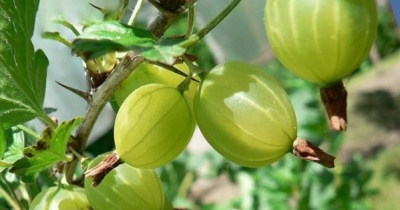
- Authors: All-Russian Research Institute of Horticulture named. I. V. Michurina
- Growth type: tall
- Description of the bush: medium spreading
- Escapes: medium, straight, matte
- Thorniness: practically absent
- Sheet: large, dark green, shiny and wrinkled
- Berry size: large
- Berry weight, g: 5-10
- Berry shape: oval or teardrop
- Berry color: light green, golden as it ripens
Gooseberries are among the healthiest. This is what determines the popularity of culture. However, the choice of gardeners is influenced not only by the benefits, but also by the convenience of growing. And here the leader is Grossular - a variety on which thorns are practically absent.
Description of the variety
Grossular was obtained thanks to the works of breeders of the All-Russian Research Institute of Horticulture. I. V. Michurin. He became one of the first studless varieties, thanks to which he immediately found his audience of admirers.
The plant is tall, up to 1.5 m, while its spreading is usually medium. Shoots are straight, dull. There are quite a lot of foliage on them, it is large and shiny, with the presence of wrinkles. The plates are dark green in color.
Characteristics of berries
The fruits of the Grossular are large, while they can be both oval and teardrop-shaped. The mass of the berries is from 5 to 10 grams. The color in the stage of immaturity is light green, and a little later the berries acquire a spectacular golden color. The skin of the fruit is thin, but rather dense. Thanks to these characteristics, this variety of gooseberries can be easily transported to the market or to the store.
Taste qualities
Absolutely all gardeners liked the taste of Grossular, because it is very harmonious and subtle. The sourness here perfectly resonates with the sweetness, and the refreshing aroma only enhances the impression. Experts rated the taste of Grossular at 4.5 points.
Ripening and fruiting
The first harvests from the bush can be expected for 2, sometimes 3 years. Then fruiting will be stable and will last for about 20 years. Medium early varieties are harvested in July-August.
Yield
Even under unfavorable weather conditions, Grossular demonstrates an excellent yield - from 5 to 7 kg per bush.
Growing regions
Since Grossular is a winter-hardy variety, it is grown without problems in many parts of the country. But still, the best indicators will be obtained in the Central and Central Black Earth regions. The plant feels very comfortable here.
Landing
It is recommended to plant bushes of this variety in the fall, since in spring they are extremely difficult to adapt to new living conditions. The shadow is absolutely unacceptable, and it is better to choose black soil or loam from the soil. There should be no excessive moisture in the soil. And also Grossular cannot be planted in those places where other berry bushes grew before.
Other recommendations:
the seedling must be absolutely healthy, with strong leaves and white roots;
the site should be dug up and cleaned, in case of increased acidity - lime;
a couple of weeks before planting, organic and mineral dressings are introduced into the ground;
hole depth - 0.4 m, width - 0.5 m;
distance between plants - 1.5 m;
after planting, the branches are shortened so that their length is 20 cm;
the planted sprout is watered and mulched.

Growing and care
Grossular is a very moisture-loving plant.It needs to be watered in a timely manner if you want to get juicy fruits. Young seedlings are irrigated twice a week, spending 10 liters per bush. If there is strong heat, the frequency of watering is increased up to three times, while it is recommended to take at least two buckets of warm water. Weed and loosen the soil about 6 times per season.
It is necessary to feed the culture annually. Nitrogen must be given in the spring. In this case, minerals are used only if the soil or plants are in poor condition. In the fall, the feeding of Grossular will be more significant.
You will need:
manure (half a bucket);
wood ash (100 grams);
superphosphate (45 grams).
These dressings are great for increasing fruiting. They are applied directly to the soil, and then buried inside with a shovel 10 cm.
The grossular will also need pruning. In the first year, it should not be carried out, but in the second it is necessary to select the 5 most powerful shoots, leave them. Anything else must be deleted. Subsequently, they maintain the shape of the bush and do not forget to remove dry and diseased branches. If the plant has crossed the 10-year line, it will need to be cut off at the root before the cold weather.



Disease and pest resistance
Grossular is not particularly good at resisting various ailments. His stability is average. Therefore, preventive treatments with fungicides in the spring are simply required.
But even more often than diseases, pests attack the shrub. These are spider mites, shoot aphids and gooseberry moths. To prevent the appearance of parasites, the shedding of the crop with var in early spring will allow, but this should be done before the buds dissolve. If you have not already had time, then it is better to use insecticides (at the initial stages of the growing season).

In order for the gooseberry to produce a good harvest, it is necessary to devote time to disease prevention.
Resistance to adverse climatic conditions
Despite the fact that the plant is very fond of moisture, it is quite capable of surviving a short-term drought. But the frost resistance of Grossular is very high, while the plant is not afraid even of recurrent frosts. It will only be necessary to shelter the culture in very harsh regions. If there is snow, it will be enough, and if the winter is not very snowy, you can use burlap, spruce branches and other shelters of your choice.




































































